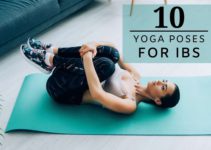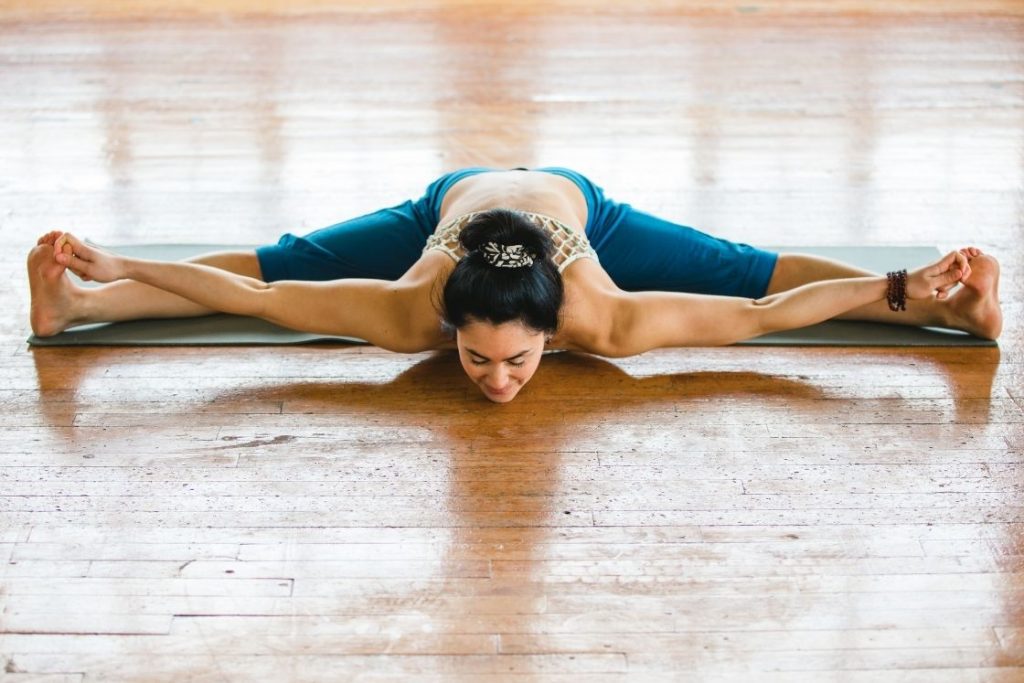
Upavistha konasana is a foundational seated forward bend pose. As it’s name shows, it is performed sitting by opening the legs wide followed by leaning forward.
In Ashtanga Yoga, it’s practiced in the primary series poses. This is an intense stretching posture that increases the elasticity in the hamstrings and adductor muscles.
This posture is exercised as a seated hip opener. Besides providing physical and psychological benefits, it also prepares the practitioner for standing wide-legged asanas.
Meaning
Upavistha Konasana is understood by focusing on word root. In Sanskrit “upvistha” means “seated”, “kona” is “angle”, and “asana” refers to “pose.” It is translated in English as Wide-Angle Seated Forward Bend.
It clarifies the asana is performed sitting on the ground with legs opened at a wide-angle. This is now followed by forward bending and rhythmic breathing. It leaves a calming effect on the brain.
The forward bend gently squeezes and massages the abdominal organs and lifts the heart-opening the chest cavity, thereby improving blood circulation.
Upavistha Konasana Practice Guide
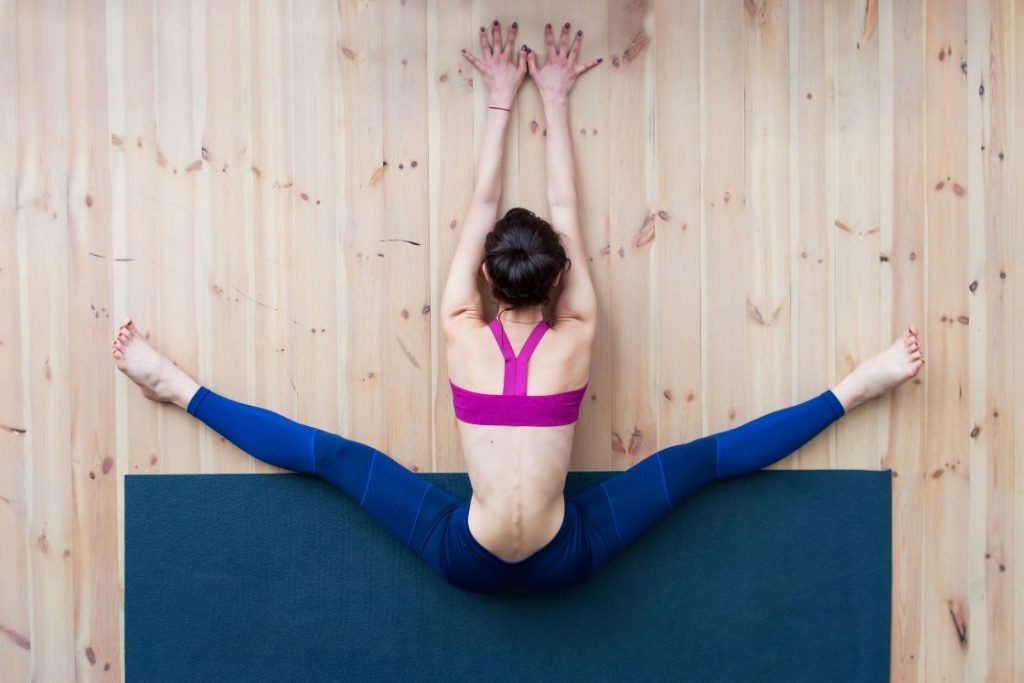
Precautions & Contraindications
- Avoid this asana if you are suffering from a slipped disc.
- Do not practice upavistha konasana in case of an injury in the back, hips, knees, or hamstrings.
- In the case of pregnancy avoid this pose.
- Don’t force yourself to lean forward after a limit if you have tight hamstrings and hip joints.
- Prevent rounding the back while practicing the pose to prevent any injury.
Preparatory poses
- Bound Angle Pose (Baddha Konasana)
- Reclining Bound Angle Pose (Supta Baddha Konasana)
- Staff Pose (Dandasana)
- Reclining Hand-to-Big-Toe Pose (Supta Padangusthasana)
- Wide-legged Forward Bend (Prasarita Padottanasana)
Steps
- Sit in dandasana.
- Spread your legs wide apart and keep your palms between your legs.
- Keep the spine erect and push your shoulders away from the ears.
- Start walking your palms forward and keep breathing gently.
- Keeping reaching forward pressing your palms to the floor as far as you feel comfortable.
- Now, gently bring your elbows to the floor and bend down fully with your head lengthening your hands.
- Inhale lift your head and place your chin to the floor.
- Keep your palms spread on the floor and look forward.
- Keep breathing normally and stay there for a few breaths.
- When you feel satisfied with the stretch, start walking your hands towards you.
- Simultaneously, bring your upper body to the center.
- Bring your hands beside your outer thighs and draw your legs together.
- Shake them a bit and relax in dandasana.
Beginner’s tip
It’s a challenging posture to achieve fully, therefore beginners are suggested to attain it by softening the knees a bit. Ensure to keep the toes pointed towards the ceiling. These tricks help to ease the pose initially.
Follow up poses
- Lotus Pose (Padmasana)
- Garland Pose (Malasana)
- Cow Face Pose (Gomukhasana)
- Crane Pose (Bakasana)
- Easy Pose (Sukhasana)
Modifications
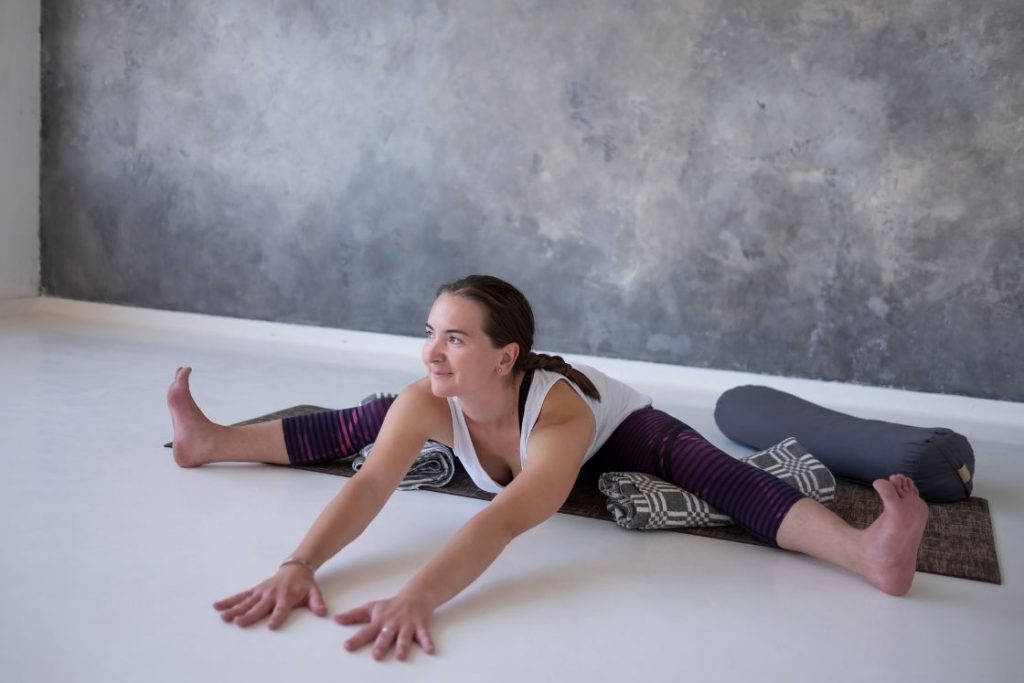
If this foundational pose is challenging for you, then use the props below to modify the pose;
- Block/ blanket – If you are feeling that the pelvic bone is shifted back, then try practicing the pose sitting on a block or folded blanket. This helps in sitting with an erect back and proper alignment. You can also keep a block to rest your palms on it when walked forward.
- Bolster – Place a bolster in front of you vertically between your legs. As you lean forward it supports your body and your head also rests on it.
- Chair – Place a chair in front of you. Extend your hands and rest your head on the chair rather than bending forward all the way to reach the floor with the head.
Variations
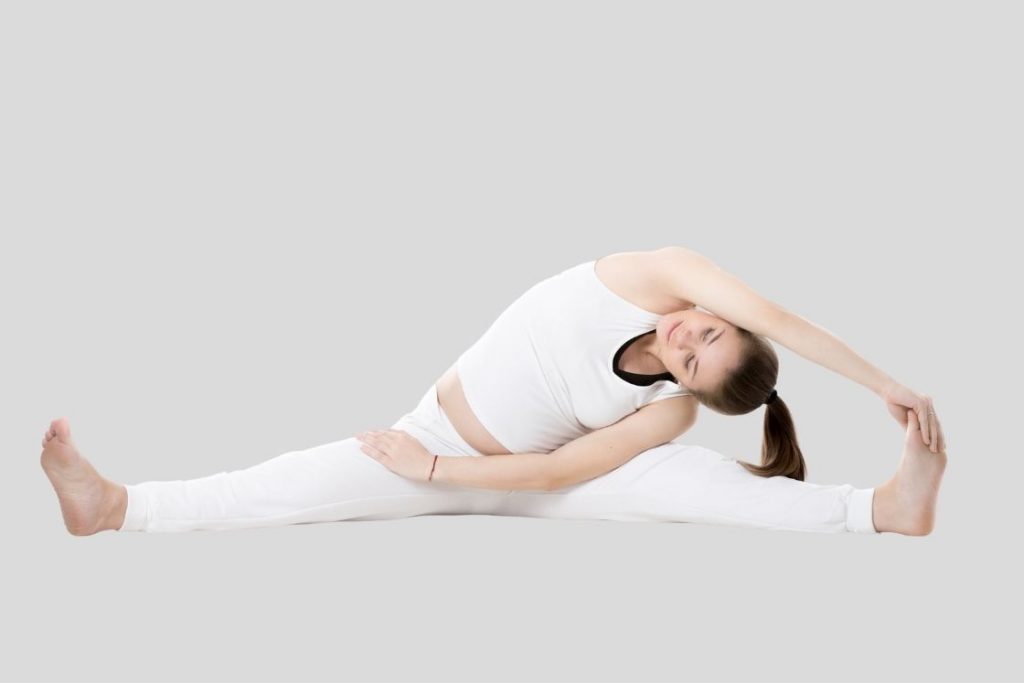
- Urdhva Upavistha Konasana – This variation of Upavistha Konasana is also practiced merudandasana.
To do this, After sitting with legs wide apart grab the big toes securing it between the index finger and middle finger of respective hands. Pulling the toes towards you bend forward as far as possible. Deepen the pose by keeping the hands to the sides of the feet. - Upavishtha Konasana B – Continuing the first variation, try coming up halfway and lift your toes off the floor. Extend your legs towards the ceiling sitting entirely on your sit bones. Open your chest drawing your shoulder blades together and look towards the ceiling
- Parivrtta Upavistha Konsasna – After sitting with legs spread wide apart, grab your right big toe with the right hand slipping from the inside of the leg. Bend your right elbow to touch the ground. Then, raise your left hand over your head to reach the side of the right foot. Release and repeat on the left foot.
- Parsva upavistha konasana – Perform parivrtta upavistha konasana reaching the right foot, then twist your torso towards your right thigh. Touch your forehead on your right knee and clutch your left wrist with your left hand at the sole. Don’t forget to repeat it on the left foot.
- Ardha Urdhva Upvistha Konasana- Start in baddha konasana. Grab your big toes wrapping index finger, middle finger, and thumb with respective hands. Stretch your right leg pulling the toes towards the right side. Bring it back to the floor and repeat the same with the left leg.
Upavistha Konasana Benefits
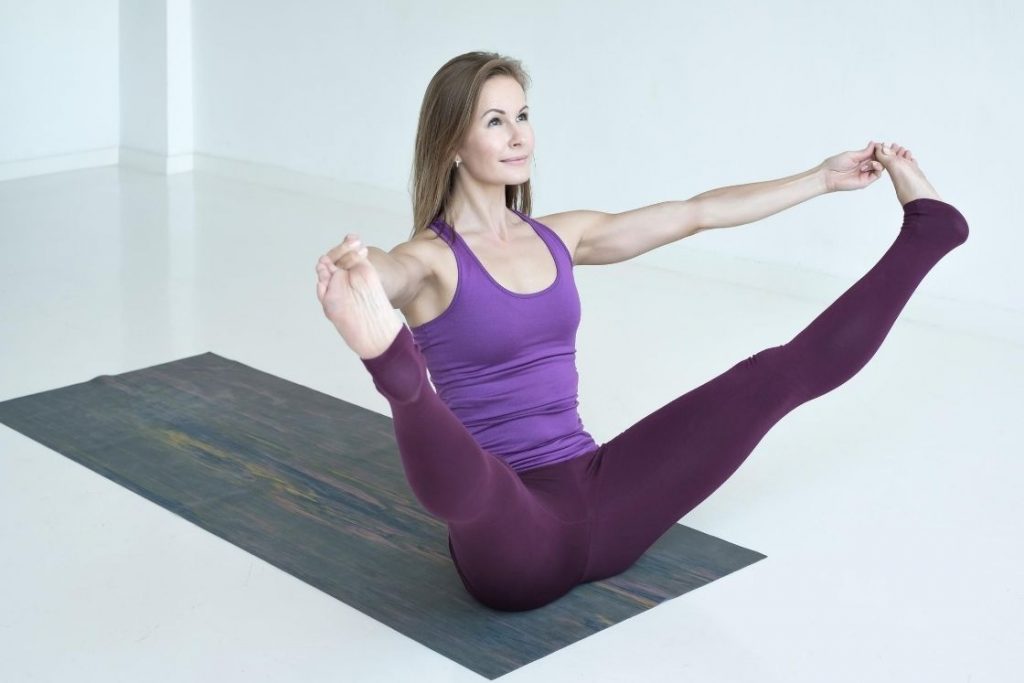
1. Enhances muscles strength
Upavistha konasana involves stretching the muscles of the lower body. It stretches the hamstrings, groins, and opens the hips. Besides this, it works on expansion of shoulders, chest, and strengthens the spine. The expansion of these muscles enhances flexibility and strength.
2. Tones abdominal organs
In this pose, when legs are wide apart at an angle and then forward bending is done, it gives a smooth stretch to abdominal muscles. It provides a gentle massage to the abdominal organs. Along with toning the abdominal organs, it also improves the digestive system.
3. Soothes nervous system
Upavistha konasana stretches the spinal muscles accompanied by rhythmic breathing. This enhances the blood flow to the brain and brings a calming effect to the brain. It enhances the efficiency of the nervous system.
This helps get rid of stress, anxiety, and other mental issues. Also, it provides sound sleep and improves memory retention.
4. Improves detoxification process
The forward bending step involves the stimulation of kidneys. This aids in the filtration of the blood and removing toxins. It is also beneficial in maintaining the health of the kidney and preventing kidney disorders.
5. Relieves sciatica
Wide-angle seated forward bend pose stretches the spine, lower back, and adductors. A study shows that these stretches provide relieving actions on severe back pain. It even cures sciatica.
6. Therapeutic benefit
This asana enhances the flexibility of the body. It enhances the elasticity of the joints and prevents joint pain. Therefore, upavistha konasana relieves joint pain and has therapeutic action on arthritis.
7. Improves sexual health
Upavistha konasana stretches the groins and stimulates the internal organs. It strengthens the pelvic muscles and massages the reproductive organs. It eases menstrual disorders.
A study proves that this pose is beneficial to overcome infertility in both men and women.
